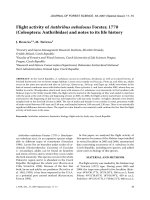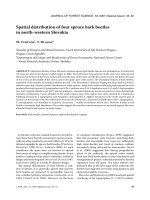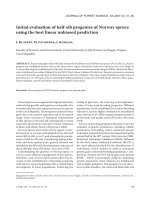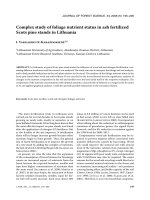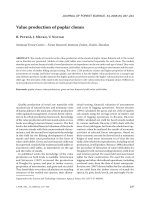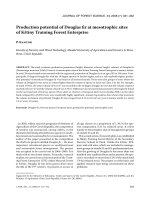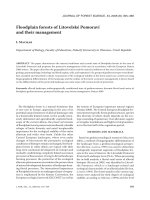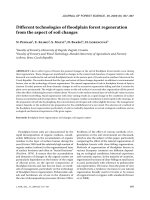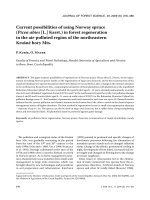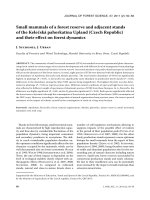Báo cáo lâm nghiệp: "Horizontal structure of forest stands on permanent research plots in the Krkonoše Mts. and its development" ppsx
Bạn đang xem bản rút gọn của tài liệu. Xem và tải ngay bản đầy đủ của tài liệu tại đây (810.96 KB, 10 trang )
J. FOR. SCI., 56, 2010 (11): 531–540 531
JOURNAL OF FOREST SCIENCE, 56, 2010 (11): 531–540
Horizontal structure of forest stands on permanent
research plots in the Krkonoše Mts.
and its development
D. Z, S. V, L. B, I. N, Z. V
Faculty of Forestry and Wood Sciences, Czech University of Life Sciences Prague,
Prague, Czech Republic
ABSTRACT: Horizontal structure on 38 permanent research plots is described for juvenile growth and developmental
phases (natural seeding, advance growth, plantations) and tree layer of a parent stand. Hopkins-Skellam index, Pielou-
Mountford index, Clark-Evans index and Ripley’s K-function were computed. The results are presented separately
for beech stands, mixed stands, spruce stands, stands in the timberline ecotone and relict pinewood. The numbers
and distribution of natural and combined regeneration recruits are mostly sufficient from the aspect of ecological,
environmental and production functions of forest. The horizontal structure of juvenile growth and developmental
phases of natural and combined regeneration shows mostly clustering; it is random or moderately regular at places
with a single dominant proportion of artificial regeneration. In the tree layer the horizontal structure of forest stands
is mostly random to moderately regular. In the future silvicultural measures should be aimed to support the structure
of homogeneous stands of younger growth phases that have originated on a large scale after the air-pollution disaster.
Keywords: Clark-Evans index; forest stands; Hopkins-Skellam index; horizontal structure; K-function; Krkonoše Mts.;
Pielou-Mountford index
e spatial structure of forest stand is a stand
framework assessed in a horizontal and vertical
direction. Stand density, stocking and canopy clo-
sure are usually investigated in forest stands from
the aspect of horizontal structure while from the
aspect of vertical structure it is the formation of
one or several stand storeys and of stand layers
within them (V 1982). In addition, S
(2002) diff erentiated between irregularity within
the crown layer, full vertical diversifi cation at the
stand level (selection structure) and horizontal di-
versifi cation (patchiness). In this aspect, appropri-
ate management of forest stands may contribute
to an increase in diversifi cation at all three above-
mentioned levels. e horizontal distribution of
trees is infl uenced to a greater extent by the way
and procedure of stand origination and by the way
of reducing the tree number by natural elimina-
tion and systematic measures of forest managers.
Man-made stands mostly have the regular original
distribution of trees whereas stands from natural
regeneration (seeding and sprouts) usually have
the clustered to randomly irregular original distri-
bution (cf. V et al. 2009). In the course of stand
development these types of distribution converge
to a moderately regular distribution. Quite an even
distribution of trees on the stand area, in connec-
tion with optimum canopy, allows good utilisation
of production space, production of high-quality
stems and maximum volume increment. On a large
scale, however, B (2002) reported higher
patchiness and fi ner texture in managed stands
than in original stands. e vertical stratifi cation
of stand is infl uenced to the greatest extent by tree
age, followed by diff erent growth rates of the par-
ticular tree types and their coenotic relations at a
given site. Accordingly, the trees take permanent
or temporal positions in stand layers. e vertical
Supported by the Ministry of Education, Youth and Sports of the Czech Republic, Project No. 2B06012.
532 J. FOR. SCI., 56, 2010 (11): 531–540
structure can be substantially infl uenced by silvi-
cultural practices. Early crown thinnings may lead
e.g. to diversifi cation of tree positions within the
canopy (Š 2006) with a positive impact
on stand stability while more pronounced vertical
diversifi cation of permanent type can be achieved
at opportune sites by the application of selection
principles in a small-area shelterwood system or
by a selection system (cf. E et al. 2000).
is procedure basically simulates the dynamics
of natural forests by intentional disturbance of the
crown canopy and by initiation of natural regen-
eration at favourable microsites in gaps. A specif-
ic problem of the spatial structure of even-aged,
uneven-aged stands and conversion stands was
studied by H (2004). In a forest of age
classes the standing volume and the largest trees
were evenly distributed on the area. With more
progressive phases of conversion and with a taller
height of the understorey its pronounced clustered
pattern, which is connected with regeneration in
gaps in the initial phase of conversion, disappears.
e gaps should not be enlarged, on the contrary,
in uneven-aged stands selective measures should
lead to the random distribution of trees of medium
and small dimensions across the stand area.
To assess possibilities of optimizing the forest
ecosystem management in national parks of the
Krkonoše Mts. the horizontal structure of forest
stands was exactly evaluated on 38 permanent re-
search plots, both in juvenile growth and develop-
mental phases (natural seeding, advance growth,
plantations) and in the tree layer.
MATERIAL AND METHOD
Description of permanent research plots
In the territory of the Krkonoše Mts., 32 permanent
research plots, designated PRP 1 to PRP 32, were es-
tablished in the 5
th
to 8
th
forest altitudinal zone. ese
PRP represent beech, mixed (spruce with beech to
beech with spruce) and spruce stands in diff erent site
conditions, with diff erent level of air-pollution im-
pacts and diff erent rate of subsequent acidifi cation.
After some time, six plots were added to reach the
total number of 38 PRP: two plots in the timberline
ecotone where research was aimed at natural vege-
tative forest regeneration – spruce and beech layer-
ing, and four plots were established in Poland, where
those stand types were selected that either do not oc-
cur in the Czech part of the Krkonoše Mts. or occur
only sporadically there (relict pinewood, beech stand
with fi r, eutrophic beech stand and acidophilic moun-
tain beech stands at a high elevation). e majority
of these plots were established in 1980 while PRP 11
to 15 were already established in 1976. e plots are
mostly 50 × 50 m in size, i.e. 0.25 ha, exception are
listed in V et al. (2010). A description of all 38
PRP, where forest regeneration was studied, is pre-
sented in the fi rst paper (M et al. 2010).
e FieldMap technology was used to determine
the structure of the upper storey of the tree layer of
tree species on PRP. On each PRP a transect 50 × 5m
in size (250 m
2
) was demarcated and stabilised, only
on PRP 6 and 7, the area of which is 0.5 and 1.0ha,
respectively, there were 2 and 4 transects, i.e. one
transect per 0.25 ha. e place of the transect de-
marcation was selected so that it would represent the
average abundance and maturity of advance growths
on the whole PRP. e transects were stabilised in
the terrain with wooden stakes. All trees present in
the particular transects, of diameter at breast height
smaller than 12 cm, were included in measurements
of natural and combined regeneration.
e horizontal structure was evaluated on the
particular plots in all recruits of regeneration and
tree layer. ese indices were calculated: Hopkins-
Skellam index (H, S 1954), Pielou-
Mountford index (P 1959, M
1961), Clark-Evans index (C, E 1954)
and Ripley’s K-function (R 1981; L 1996).
e horizontal structure of regeneration relates to
2009 and of the tree layer to the year of PRP es-
tablishment. e respective expected values of
these indices were computed by means of numeri-
cal simulations for each specifi c case separately. In
tables describing the particular PRP the column
of expected value shows the value of the index for
random distribution. e columns of lower limit
and upper limit show the interval around this ex-
pected value in which the randomness of distribu-
tion cannot be rejected yet. Only when the value of
the index exceeds the upper limit of the interval,
it is possible to state (at a 0.05 signifi cance level)
that the point structure is aggregated (for Hopkins-
Skellam and Pielou-Mountford index) or regular
(for Clark-Evans index). On the contrary, if the
value of the index does not reach the lower limit of
the interval, it shows regularity in Hopkins-Skellam
and Pielou-Mountford index or aggregation in the
case of Clark-Evans index.
Diff erences in the horizontal structure were
quantifi ed by Ripley’s K-function and represented
graphically. e x-axis shows a distance between
recruits of natural regeneration in metres and the
y-axis shows the value of K-function – K(r). is
J. FOR. SCI., 56, 2010 (11): 531–540 533
value documents the mean number of recruits
that would occur in a circle of the radius r around
a randomly selected recruit on condition that the
recruits on the plot showed unit density (i.e. 1 re-
cruit per 1 m
2
in this case). In the fi gures the black
line represents the K-function for actual distances
of natural regeneration recruits in the transects of
PRP and the three central curves illustrate the K-
function for the random spatial distribution of trees
and its 95% reliability interval. When the black line
of the tree distribution on PRP is drawn above this
interval, it indicates the trend of recruit clustering;
if the line is drawn below this interval, it shows the
trend of regular distribution.
Ripley’s K-function can be defi ned (D 1983)
as follows:
(1)
where:
E (
n
r
) – the mean number of points (trees), the distance
of which from a randomly chosen point is smaller
than r,
λ – density, i.e. the number of points per unit area.
If the mechanism generating point distribution
on the plot is known, it is also possible to calculate
the expected form of K-function. E.g. for obviously
random point distribution it holds good K(r) =δr
2
.
In case that the value K(r) calculated from real data
is higher than the above-mentioned expected val-
ue, it can be interpreted as a trend of point clus-
tering along distance r. On the contrary, the lower
value K(r) indicates the trend of repulsion, i.e. of
the formation of regular point structures.
When the K-function is estimated from real data
in operational conditions, it is necessary to solve
problems arising from defi nite dimensions of a sam-
ple plot, especially the infl uence of the edge eff ect.
In this case the estimation of K-function was done
according to the formula (P et al. 1992):
(2)
where: s(r) is Ohser’s correction of edge effect, the value
of which for a sample plot in the shape of a rectangle
with sides a and b, a < b, is calculated from the equation
s(r) = ab – r(2a + 2b –r)/δ 0< r < a (3)
e test of signifi cance of K(r) deviations from
the values expected for a random point pattern was
done by means of Monte Carlo simulations. e
mean values of K-function were estimated as arith-
metic means ofK-functions calculated for a large
number (3,999) of randomly generated point struc-
tures. In the fi gures these mean curves are repre-
sented by a solid blue line. e envelope tangent
to 95% of the values of K-functions for randomly
generated structures is represented by thinner blue
lines. e randomness of the mechanism generat-
ing a real point structure will be rejected (on a 0.05
signifi cance level) for distances where the respec-
tive K-function exceeds this envelope.
RESULTS AND DISCUSSION
Beech stands
PRP 31 – U Hadí cesty F
Forest stand 542 C15/1b with PRP 31 – U Hadí
cesty F is situated on a slope of medium gradient
and northeastern exposure. It is quite a closed
grown-up beech high forest with interspersed syc-
amore maple and Norway spruce. From the aspect
of the small forest development cycle this stand is
at the ultimate stage of optimum to the initial stage
of disintegration with regeneration phase.
e total number of natural regeneration recruits
highly exceeds the values recommended for the
density of artifi cial regeneration of beech in pro-
duction forests (5,000–10,000 recruits per ha ac-
cording to B, H 1997), reaching 73,800
recruits per ha for all tree species: beech accounted
for 68%, sycamore maple for 22% and rowan for 9%,
and the representation of the other species (Nor-
O
r
nE
rK
¦
d
rxx
ji
ji
xxs
rK
0
2
1
O
ˆ
ˆ
Table 1. e values of indices of the horizontal structure of natural regeneration and tree layer recruitment on PRP31
– U Hadí cesty F
Index
Natural generation Tree layer
values bound values bound
observed expected lower upper observed expected lower upper
Hopkins-Skellam 0.686 0.488 0.481 0.525 0.345 0.498 0.401 0.608
Pielou-Mountford 2.079 1.019 1.002 1.121 0.800 1.114 0.831 1.524
Clark-Evans 0.892 0.990 0.986 1.046 1.267 1.049 0.920 1.170
534 J. FOR. SCI., 56, 2010 (11): 531–540
way spruce, European ash and red elderberry) was
mostly lower than 1%. Due to the relatively slow
and irregular opening-up of the canopy the height
and diameter diff erentiated natural regeneration is
gradually formed there.
Table 1 shows the values of indices of the horizon-
tal structure of recruits and tree layer. According to
all three determined structural indices (Hopkins-
Skellam, Pielou-Mountford and Clark-Evans) natu-
ral regeneration on this PRP is aggregated and the
distribution of the tree layer recruits is moderately
regular. e relatively considerable clustering of re-
cruits according to their distance (spacing) is also
documented by Ripley’s K-function (Fig. 1); the
distribution of individuals of the tree layer is mod-
erately regular according to this function.
Mixed stands
PRP 7 – Bažinky 1
Forest stand 311 A17/4/1a with PRP 7 – Bažinky1 is
situated on a slope of medium gradient and eastern
exposure. It is a partially open grown-up spruce-
beech high forest with abundant natural seeding
of mainly European beech and Norway spruce of
diff erent age and height. From the aspect of the
small forest development cycle this stand is at the
medium-advanced disintegration stage with regen-
eration phase.
e total per-hectare number of natural regen-
eration recruits exceeds the values of the preceding
PRP: 96,720 recruits, of them European beech ac-
counts for 87%, Norway spruce for 12%, rowan for
1% and the proportion of goat willow is minimal.
Due to the gradual opening-up of the canopy with
continuing stand disintegration the height and di-
ameter largely diff erentiated natural regeneration
was formed there.
Table 2 documents the values of indices of the
horizontal structure of natural regeneration and
tree layer recruitment. According to all three de-
termined structural indices (Hopkins-Skellam,
Pielou-Mountford and Clark-Evans) natural regen-
eration on this PRP is aggregated. Two structural
indices (Hopkins-Skellam and Pielou-Mountford)
show moderate clustering of the tree layer recruits
on this PRP while the Clark-Evans index indicates
their random distribution. Relatively considerable
clustering of natural regeneration recruits accord-
ing to their distance (spacing) also follows from Ri-
pley’s K-function (Fig. 2A); the distribution of the
Fig. 1. (A) Horizontal structure of natural regeneration and (B) tree layer on PRP 31 – U Hadí cesty F expressed by
K-function
Table 2. e values of indices of the horizontal structure of natural regeneration and tree layer recruitment on PRP7
– Bažinky 1
Index
Natural regeneration Tree layer
values bound values bound
observed expected lower upper observed expected lower upper
Hopkins-Skellam 0.783 0.486 0.479 0.524 0.604 0.499 0.440 0.568
Pielou-Mountford 3.168 1.012 0.985 1.116 1.452 1.068 0.901 1.284
Clark-Evans 0.831 0.991 0.990 1.044 0.977 1.027 0.958 1.101
(A)
(B)
16
14
12
10
8
6
4
2
0
K(r)
340
300
260
220
180
140
100
60
20
K(r)
0.2 0.4 0.6 0.8 1.0 1.2 1.4 1.6 1.8 2.0
Distance (m)
1 2 3 4 5 6 7 8 9 10
Distance (m)
J. FOR. SCI., 56, 2010 (11): 531–540 535
Fig. 2. (A) Horizontal structure of natural regeneration and (B) tree layer of spruce-beech stand expressed by
K-function on PRP 7 – Bažinky 1 – transect 1a
tree layer individuals is mostly random according
to this function whereas trees with spacing larger
than 7 m show a clustering pattern (Fig. 2B).
Spruce stands
PRP 21 – Modrý důl
Forest stand 233 A14 with PRP 21 – Modrý důl
is situated on a slope of medium gradient and
southern exposure. It is quite a closed grown-up
spruce high forest with the partial incipient natural
seeding of Norway spruce. From the aspect of the
small forest development cycle this stand is at the
stage of optimum with the incipient unpronounced
phase of regeneration.
e total per-hectare number of natural regen-
eration recruits is 7,360, and this is only Norway
spruce recruitment. Individual trees of rowan
(Sorbus aucuparia subsp. glabrata) occur sporadi-
cally on this PRP only outside the studied transect.
Due to the irregular opening-up of the canopy the
height and diameter diff erentiated natural regen-
eration of Norway spruce was formed, mostly in
small biogroups or individually at markedly elevat-
ed places (mostly around root swelling) or in rows
on rotting stems.
Table 3 shows the values of indices of the horizon-
tal structure of natural regeneration recruits. Ac-
cording to all three determined structural indices
(Hopkins-Skellam, Pielou-Mountford and Clark-
Evans) natural regeneration on this PRP is largely
aggregated and the distribution of the tree layer in-
dividuals on the plot is random. Ripley’s K-function
(Fig. 3A) also shows very pronounced clustering of
natural regeneration recruits according to their
distance (spacing); the distribution of the tree lay-
er individuals is mostly random according to this
function while the pattern is moderately regular at
a spacing of 4.6–4.8 m and 5.6–5.8 m (Fig. 3B).
PRP 3 – U Lubošské bystřiny
Forest stand 514 A2/1a with PRP 3 – U Lubošské
bystřiny is situated on a slope of medium gradi-
(A)
(B)
16
14
12
10
8
6
4
2
0
360
320
280
240
200
160
120
80
40
0
K(r)
0.2 0.4 0.6 0.8 1.0 1.2 1.4 1.6 1.8 2.0
Distance (m)
1 2 3 4 5 6 7 8 9 10
Distance (m)
K(r)
Fig. 3. (A) Horizontal structure of natural regeneration and (B) the tree layer of spruce stand expressed by K-function
on PRP 21 – Modrý důl
(A)
(B)
22
20
18
16
14
12
10
8
6
4
2
0
340
300
260
220
180
140
100
60
20
K(r)
0.2 0.4 0.6 0.8 1.0 1.2 1.4 1.6 1.8 2.0
Distance (m)
1 2 3 4 5 6 7 8 9 10
Distance (m)
K(r)
536 J. FOR. SCI., 56, 2010 (11): 531–540
ent and southwestern exposure. It is a highly dif-
ferentiated young plantation to young growth that
mostly originated by artifi cial regeneration in the
stand that was at the stage of disintegration due
to the impacts of air pollution and bark beetle (Ips
typographus). After the declining stand was felled,
reforestation with blue spruce (Picea pungens) and
dwarf pine (Pinus mugo) was carried out. On the
contrary, Norway spruce and rowan mostly origi-
nated from natural regeneration. e open young
plantation to young growth of blue spruce with
admixed dwarf pine and Norway spruce and inter-
spersed rowan is quite even-aged even though the
reforestation including repeated repair planting
lasted for 9 years. Losses of the fi rst reforestation
were 42% while they amounted to 57% on average
in subsequent 4 repair plantings. e highest losses
of 68% were recorded in blue spruce, in dwarf pine
they were only 19%. From the aspect of the great
forest development cycle it is a pioneer forest with
some traits of transitional forest. e proportion of
artifi cial regeneration recruits is 91%.
Not very prosperous regeneration in the transect
on PRP 3 is relatively suffi cient only from the as-
pect of the soil-conservation function. Its total per-
hectare number is 3,240 recruits while blue spruce
is a markedly dominant species (78%), dwarf pine
(12%) and Norway spruce(9%) are admixed, and
rowan (1%) is interspersed.
Table 4 documents the values of indices of the
horizontal structure of combined regeneration and
tree layer recruits. According to Hopkins-Skellam
and Clark-Evans indices the combined regenera-
tion on this PRP shows a moderately regular pat-
tern whereas according to Pielou-Mountford index
its pattern is random. e distribution of the tree
layer individuals was random according to two
structural indices (Hopkins-Skellam and Pielou-
Mountford) and regular according to Clark-Evans
index. Ripley’s K-function (Fig. 4A) also indicates
the mostly moderately regular distribution and
only edge random distribution (in the smallest and
largest spacings) of combined regeneration recruits
according to their distance (spacing); according to
this function the distribution of the tree layer indi-
viduals was regular at a tree spacing smaller than
3.1 m and random at a larger spacing (Fig. 4B).
Forest stands in the timberline ecotone
PRP 34 – Liščí hora
Forest stand 405 B15a/4 with PRP 34 – Liščí hora
is situated on a slope of medium gradient and south-
western exposure. It is mostly rather an open spruce
stand with pronounced spatial and age diff erentia-
tion. From the aspect of the small forest development
cycle the stand is at the stage of optimum with regen-
eration phase. It is a stand of phenotype class C, char-
acterized by two storeys. Due to the large opening-up
of the canopy of the upper tree layer (25% canopy)
spruce crowns touch the ground, which is a basic pre-
Table 4. e values of indices of the horizontal structure of combined regeneration recruitment on PRP 3 – U Lu-
bošské bystřiny
Index
Natural regeneration Tree layer
values bound values bound
observed expected lower upper observed expected lower upper
Hopkins-Skellam 0.389 0.497 0.391 0.613 0.440 0.498 0.384 0.625
Pielou-Mountford 0.997 1.203 0.867 1.665 1.070 1.132 0.807 1.611
Clark-Evans 1.298 1.084 0.943 1.219 1.242 1.056 0.915 1.200
Table 3. e values of indices of the horizontal structure of natural regeneration recruitment on PRP 21 – Modrý důl
Index
Natural regeneration Tree layer
values bound values bound
observed expected lower upper observed expected lower upper
Hopkins-Skellam 0.860 0.499 0.434 0.571 0.493 0.498 0.424 0.583
Pielou-Mountford 4.500 1.132 0.932 1.389 1.128 1.088 0.872 1.382
Clark-Evans 0.575 1.051 0.967 1.136 1.052 1.037 0.944 1.129
J. FOR. SCI., 56, 2010 (11): 531–540 537
Fig. 4. (A) Horizontal structure of combined regeneration (B) the tree layer of spruce stand expressed by K-function
on PRP3 – U Lubošské bystřiny
condition for layering. Under the infl uence of quite
favourable soil conditions (modal Podzol) and ground
vegetation the natural vegetative regeneration of
spruce takes place there. e total per-hectare num-
ber of layered spruce branches is 68.
Table 5 shows the values of indices of the horizon-
tal structure of spruce recruits from natural vegeta-
tive regeneration (layered branches). According to
Hopkins-Skellam and Clark-Evans indices natural
regeneration on this PRP is aggregated. According to
Pielou-Mountford index the distribution of spruce
layers on this PRP is random. e distribution of
the tree layer individuals is random according to all
three indices. e random pattern of layered spruce
Fig. 5. (A) Horizontal structure of spruce natural vegetative regeneration (B) the tree layer of spruce stand expressed
by K-function on PRP 34 – Liščí hora
Table 5. e values of indices of the horizontal structure of recruitment from spruce natural vegetative regeneration
on PRP 34 – Liščí hora
Index
Natural regeneration Tree layer
values bound values bound
observed expected lower upper observed expected lower upper
Hopkins-Skellam 0.644 0.498 0.382 0.629 0.606 0.496 0.369 0.648
Pielou-Mountford 1.367 1.133 0.806 1.628 1.244 1.146 0.770 1.736
Clark-Evans 0.884 1.057 0.909 1.199 0.928 1.066 0.894 1.239
(A)
(B)
14
12
10
8
6
4
2
0
K(r)
0.2 0.4 0.6 0.8 1.0 1.2 1.4 1.6 1.8 2.0
Distance (m)
1 2 3 4 5 6 7 8 9 10
Distance (m)
(A)
(B)
24
22
20
18
16
14
12
10
8
6
4
2
0
340
300
260
220
180
140
100
60
20
K(r)
0.2 0.4 0.6 0.8 1.0 1.2 1.4 1.6 1.8 2.0
Distance (m)
1 2 3 4 5 6 7 8 9 10
Distance (m)
K(r)
K(r)
360
320
280
240
200
160
120
80
40
0
538 J. FOR. SCI., 56, 2010 (11): 531–540
er individuals on this plot is documented by two
structural indices (Hopkins-Skellam and Clark-
Evans) while the Pielou-Mountford index shows
their random pattern. Very pronounced clustering
of natural regeneration recruits according to their
distance (spacing) is also indicated by Ripley’s func-
tion (Fig. 6A); the distribution of the tree layer indi-
viduals is mostly random according to this function
while their clustering is shown at a spacing smaller
than 2 m (Fig. 6B).
CONCLUSION
More than 30-year systematic research on the
structure of forest ecosystems in national parks of
the Krkonoše Mts. has brought about the knowl-
edge of successions of developmental stages and
phases in the most important stand types of the
Krkonoše Mts. forests, both in relatively natu-
ral environmental conditions and in conditions
of pronounced air-pollution stress in the eighties
of the 20
th
century accompanied by rather heavy
bark beetle disturbance. e acquired knowledge
of stand structure and development will be appli-
cable to the defi nition of close-to-nature manage-
branches according to their distance (spacing) also
results from Ripley’s K-function (Fig. 5A); the pat-
tern of the tree layer individuals according to this
function is mostly random (Fig. 5B).
Relict pinewoods
PRP 37 – Chojnik – relict pinewood
Forest stand 213g with PRP 37 – Chojnik – relict
pinewood is situated on a slope of medium gradi-
ent and northeastern exposure. It is a considerably
open grown-up high forest with the partial natu-
ral seeding of European beech, sessile oak, Scotch
pine, silver birch and other tree species of diff erent
age and height.
e total per-hectare number of natural regenera-
tion recruits is 12,080: European beech accounts for
72%, sessile oak for 15%, Scotch pine for 7%, silver
birch for 3%, rowan for 2%, Norway spruce for 1%
and the proportion of sycamore maple is minimal.
Table 6 shows the values of indices of the hori-
zontal structure of natural regeneration recruit-
ment. According to all three determined structural
indices (Hopkins-Skellam, Pielou-Mountford and
Clark-Evans) natural regeneration on the PRP is
highly aggregated. e clustering of the tree lay-
Table 6. e values of indices of the horizontal structure of natural regeneration recruitment on RPR 37 – Chojnik
– relict pinewood
Index
Natural regeneration Tree layer
values bound values bound
observed expected lower upper observed expected lower upper
Hopkins-Skellam 0.810 0.499 0.445 0.554 0.569 0.500 0.441 0.565
Pielou-Mountford 3.174 1.107 0.960 1.292 1.276 1.072 0.904 1.289
Clark-Evans 0.710 1.040 0.976 1.110 0.947 1.028 0.954 1.101
Fig. 6. (A) Horizontal structure of natural regeneration and (B) the tree layer with Scotch pine expressed by K-function
on PRP 37 – Chojnik – relict pinewood
(A)
(B)
20
18
15
14
12
10
8
6
4
2
0
320
280
240
200
160
120
80
40
0
K(r)
0.2 0.4 0.6 0.8 1.0 1.2 1.4 1.6 1.8 2.0
Distance (m)
1 2 3 4 5 6 7 8 9 10
Distance (m)
K(r)
J. FOR. SCI., 56, 2010 (11): 531–540 539
ment and to the documentation of a great impact
of anthropogenic processes (mainly of air pollution
and forest management) on the condition and de-
velopment of the Krkonoše Mts. forests.
e numbers and distribution of natural and
combined regeneration recruits are mostly suffi -
cient from the aspect of ecological, environmental
and production functions of forest. e horizon-
tal structure of juvenile growth and developmen-
tal phases of natural and combined regeneration
shows mostly clustering; it is random to moderate-
ly regular at places with a single dominant propor-
tion of artifi cial regeneration. On the contrary, in
the tree layer the horizontal structure of stands at
the stage of optimum to incipient disintegration is
random to moderately regular. In general, young-
er forest generations with spontaneous develop-
ment show a tendency of clustering while older
generations of trees tend to higher regularity with
increasing age. According to W (2005) two an-
tagonistic sets of processes are behind these chang-
es: on the one hand, competition among neighbors
in dense groups leads to more regular distribution
of trees on the plot, on the other hand, aggrega-
tions are conditioned by the patchiness of diff erent
microsites, gaps in the canopy and management
system. Although it is not possible to determine
the exact characteristics of horizontal structure of
natural stands, according to the above author the
monitoring of the spatial structure can be used as
an indicator of the degree of forest stand natural-
ness but always with regard to given site condi-
tions and stand type. From the aspect of horizontal
structure, during the small forest development cy-
cle, the majority of the stands in national parks of
the Krkonoše Mts. proceed from a pronouncedly
to moderately clustered pattern at the growing-up
stage to random or moderately regular distribution
of trees on the plot at the stage of optimum and
at the incipient stage of disintegration. At the ad-
vanced stage of disintegration the horizontal struc-
ture of the tree layer is largely variable. e regular
pattern of the horizontal structure is also infl u-
enced by the intensity of silvicultural measures, es-
pecially in the period of thinnings (it increases at
their higher intensity).
Currently, the disintegration of old stands is con-
tinuous at some places, but its intensity is markedly
lower. e clear-cut areas that originated after the
air pollution disaster have been successfully regen-
erated for the most part, and now they are mostly
at the phase of young growth or at small-pole stage
with poor horizontal structure. In the nearest future
these young stands will require more intensive sil-
vicultural practices aimed at an increase in stability,
species and spatial diversifi cation and conversion of
stands that are not suitable for a certain reason.
From methodological aspects, the horizontal
structure of forest stands is described much bet-
ter by K-function than by the assessed structural
indices (Hopkins-Skellam, Pielou-Mountford and
Clark-Evans). e Clark-Evans index has the lowest
informative capacity of these indices.
References
B A. (2000): Comparison of structure and biodiversity
in the Rajhenav virgin forest remnant and managed for-
est in the Dinaric region of Slovenia. Global Ecology and
Biogeography, 9: 201–211.
B P., H J. (1997): Grundriß des Waldbaus: ein
Leitfaden für Studium und Praxis. 2. Aufl . Berlin, Parey
Buchverlag: 487.
C P.J., E F.C. (1954): Distance to nearest neighbour
as a measure of spatial relationship in populations. Ecol-
ogy, 35: 445–453.
D P.J. (1983): Statistical Analysis of Spatial Point Pat-
terns. London, Academic Press: 148.
E J., C M., H-C J. (2000):
e structural dynamics of Suserup Skov, a near-natural
temperate deciduous forest in Denmark. Forest Ecology
and Management, 126: 173–189.
H M. (2004): Spatial patterns in mixed coniferous
even-aged, uneven-aged and conversion stands. European
Journal of Forest Research, 123: 139–155.
H B., S J.G. (1954): A new method for deter-
mining the type of distribution of plant individuals. Annals
of Botany, 18: 213–227.
L J. (1996): Biostatistics. České Budějovice, Jihočeská
univerzita: 166. (in Czech)
M K., V S., P V. (2010): Develop-
ment of forest soils in the Krkonoše Mts. in the period
1980–2009. Journal of Forest Science, 56: 485–504.
M M.D. (1961): On E. C. Pielou’s index of non-
randomness. Journal of Ecology 49: 271–275.
P E.C. (1959): e use of point-to-plant distances in
the study of the pattern of plant populations. Journal of
Ecology, 47: 607–613.
P A., S D., H H. (1992): Marked
point processes in forest statistics. Forest Science, 38:
806–824.
R B.D. (1981): Spatial statistics. New York, John Wiley
& Sons: 252
S J. P. (2002): Silvicultural tools to develop irregular
and diverse forest structures. Forestry, 75: 329–337.
Š I. (2006): Changes in tree species composition,
stand structure, qualitative and quantitative production of
540 J. FOR. SCI., 56, 2010 (11): 531–540
mixed spruce, fi r and beech stand on Stará Píla research
plot. Journal of Forest Science, 52: 74–79.
V S. (1982): Ecological aspects of biomass decomposi-
tion in autochthonous protection spruce stands. Zprávy
lesnického výzkumu, 27: 5–11. (in Czech)
V S., V Z., S O., R A., N I.,
B Z., B D., B Z., R V.,
H E., Z D., M M., H
V., B M., B L M V., Š R., B J.
(2009): Regeneration of Forest Stands on Research Plots in
the Krkonoše National Parks. Kostelec nad Černými lesy,
Lesnická práce: 288. (in Czech)
V S., V Z., B L., N I., S O.
(2010): Structure and development of forest stands on
permanent research plots in the Krkonoše Mts. Journal of
Forest Science, 56: 518–530.
W A. (2005): Fifty year record of change in tree spatial
patterns within a mixed deciduous forest. Forest Ecology
and Management,215: 212–223.
Received for publication February 19, 2010
Accepted after corrections July 2, 2010
Corresponding author:
Prof. RNDr. S V, DrSc., Česká zemědělská univerzita, Fakulta lesnická a dřevařská,
Kamýcká 129, 165 21 Praha 6-Suchdol, Česká republika
tel.: + 420 224 382 870, fax: + 420 234 381 860, e-mail: vacekstanislav@fl d.czu.cz
